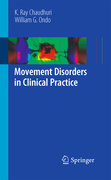
Movement disorders are a complex group of disorders spanning all aspects of neurological illnesses and ranging from conditions characterised by too little movement (hypokinesis) to those where movement is excessive (hyperkinesis). Diagnosis is based mostly on observation and examination rather than radiology and serological assessments. The classic example would be Parkinson’s disease, while other movement-related problems, such as tremor, chorea, dystonia, myoclonus, hemiballism and tics, occur in a range of inherited, drug-induced and sporadic disorders. Genetics plays an important part in the genesis of several conditions characterised by various movement disorders, such as Huntington’s disease, dystonic conditions and myoclonus. Somatisation from psychologically determined conditions can also manifest as movement disorders. Finally, sleep may be affected by movement disorder and a typical example would be restless legs syndrome. This concise, practical book, edited by two key international movement disorder experts, deals with all the above movement disorders in a holistic manner, providing a detailed 'snapshot' view of these complex disorders. A concise but comprehensive overview of the diagnosis, treatment and management of common and rarer movement disorders from two key international movement disorder experts Clinically focussed and accessible it will provide a practical guide to the assessment of these complex disorders where diagnosis relies on examination and observation rather than radiology and serological assessments INDICE: Contents.- 1. Parkinson’s disease - Introduction - Epidemiology, incidence, and prevalence - Risk factors - Genetic factors - Pathophysiology - Symptoms and signs - Confirmation of diagnosis - Management of Parkinson’s disease - Neuroprotection - Stereotactic thalamotomy and deep brain stimulation -Transplant therapies - Nondopaminergic drug therapy - Specialist nursing care- Cost of care - Mortality and prognosis - Conclusions.- 2. Parkinsonian syndromes - Introduction - Neurodegeneration-linked parkinsonism - Multiple systematrophy - Progressive supranuclear palsy - Dementia with Lewy bodies - Corticobasal degeneration - Vascular pseudoparkinsonism - Other parkinsonian syndromes - Management - Conclusions.- 3. Dystonia - Definition - Classification - Location - Pathophysiology - Epidemiology - Genetics - Signs and symptoms - History and investigations - Treatments - Conclusions.- 4. Essential tremor - Introduction - Tremor subtypes and differential diagnosis - Physical examination and clinical evaluation - Epidemiology and neuropathology - Treatment.- 5. Restless legs syndrome -Restless legs syndrome - Periodic limb movements of sleep - RLS in children - Diagnostic evaluation - Epidemiology - Genetics - Pathophysiology - Treatment.- 6. Other movement disorders - Drug-induced movement disorders - Tics and Tourette’s syndrome - Chorea, ballismus and athetosis - Myoclonus - Ataxia - conclusions.
- ISBN: 978-1-84996-064-9
- Editorial: Springer
- Encuadernacion: Rústica
- Páginas: 100
- Fecha Publicación: 01/03/2010
- Nº Volúmenes: 1
- Idioma: Inglés
